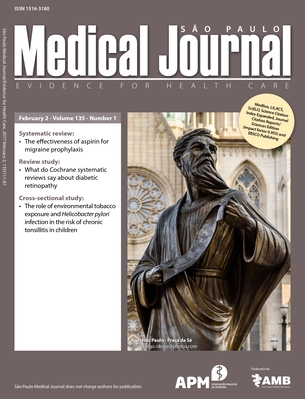What do Cochrane systematic reviews say about diabetic retinopathy?
Keywords:
Review [publication type], Diabetic retinopathy, Therapeutics, Evidence-based medicine, Evidence-based practiceAbstract
CONTEXT AND OBJECTIVE: Diabetic retinopathy is a disease caused by increased permeability of retinal vessels. Its incidence and prevalence have been increasing due to urbanization, greater life expectancy and the habits of modern life. Its onset is insidious and it may lead to blindness in 75% of individuals who have been diabetic for more than 20 years. The aim here was to evaluate the evidence from Cochrane systematic reviews on interventions relating to diabetic retinopathy. DESIGN AND SETTING: Review of systematic reviews, conducted at Cochrane Brazil. METHODS: We included Cochrane systematic reviews on interventions relating to diabetic retinopathy. Two researchers evaluated the inclusion criteria, summarized the reviews and presented the results narratively. RESULTS: Ten reviews met the inclusion criteria. They showed some evidence of benefits from: (a) photocoagulation for diabetic retinopathy; (b) strict glucose and pressure control for postponing the onset of retinopathy; (c) antiangiogenic drugs for macular edema (high-quality evidence); (d) antivascular endothelial growth factor agents for proliferative diabetic retinopathy (very low to low-quality evidence); and (e) intravitreal injection or surgical implantation for treating persistent or refractory macular edema. However, blood pressure control seems to have no benefit after the onset of retinopathy. CONCLUSION: Only a few options are likely to be effective for treating diabetic retinopathy. These include photocoagulation and anti-vascular endothelial growth factor agents. Strict glucose and pressure control seem to postpone the onset of retinopathy. For macular edema, antiangiogenic drugs, intravitreal injection and surgical implantation seem to have some benefit.
Downloads
References
Zheng Y, He M, Congdon N. The worldwide epidemic of diabetic retinopathy. Indian J Ophthalmol. 2012;60(5):428-31.
World Health Organization. Prevention of Blindness from Diabetes Mellitus. Report of WHO consultation in Geneva, Switzerland, 9-11 November 2005. Available from: http://www.who.int/blindness/Prevention%20of%20Blindness%20from%20Diabetes%20Mellitus-with-cover-small.pdf Accessed in 2017 (Feb 2).
Deanfield JE, Halcox JP, Rabelink TJ. Endothelial function and dysfunction: testing and clinical relevance. Circulation. 2007;115(10):1285-95.
Kennedy L, Mehl TD, Elder E, Varghese M, Merimee TJ. Nonenzymatic glycosylation of serum and plasma proteins. Diabetes. 1982;31(Suppl 3):52-6. Available from: http://diabetes.diabetesjournals.org/content/31/Supplement_3/52 Accessed in 2017 (Feb 2).
Bunn HF. Nonenzymatic glycosylation of proteins: relevance to diabetes. Ann J Med. 1981;70(2):325-30.
Furth AJ. Glycated proteins in diabetes. Br J Biomed Sci. 1997;54(3):192-200.
Baynes JW. Role of oxidative stress in development of complication in diabetes. Diabetes. 1991;40(4):405-12.
Grading diabetic retinopathy from stereoscopic color fundus photographs--an extension of the modified Airlie House classification. ETDRS report number 10. Early Treatment Diabetic Retinopathy Study Research Group. Ophthalmology. 1991;98(5 Suppl):786-806.
Klaassen I, Van Noorden CJ, Schlingemann RO. Molecular basis of the inner blood-retinal barrier and its breakdown in diabetic macular edema and other pathological conditions. Prog Retin Eye Res. 2013;34:19-48.
Treatment techniques and clinical guidelines for photocoagulation of diabetic macular edema. Early Treatment Diabetic Retinopathy Study Report Number 2. Early Treatment Diabetic Retinopathy Study Research Group. Early Treatment Diabetic Retinopathy Study Research Group. Ophthalmology. 1987;94(7):761-74.
Early photocoagulation for diabetic retinopathy. ETDRS report number 9. Early Treatment Diabetic Retinopathy Study Research Group. Ophthalmology. 1991;98(5 Suppl):766-85.
Smith JM, Steel DH. Anti-vascular endothelial growth factor for prevention of postoperative vitreous cavity haemorrhage after vitrectomy for proliferative diabetic retinopathy. Cochrane Database Syst Rev. 2015;(8):CD008214.
Sahoo S, Barua A, Myint KT, et al. Topical non-steroidal anti-inflammatory agents for diabetic cystoid macular oedema. Cochrane Database Syst Rev. 2015;(2):CD010009.
Do DV, Wang X, Vedula SS, et al. Blood pressure control for diabetic retinopathy. Cochrane Database Syst Rev. 2015;1:CD006127.
Evans JR, Michelessi M, Virgili G. Laser photocoagulation for proliferative diabetic retinopathy. Cochrane Database Syst Rev. 2014;(11):CD011234.
Martinez-Zapata MJ, Martí-Carvajal AJ, Solà I, et al. Anti-vascular endothelial growth factor for proliferative diabetic retinopathy. Cochrane Database Syst Rev. 2014;(11):CD008721.
Virgili G, Parravano M, Menchini F, Evans JR. Anti-vascular endothelial growth factor for diabetic macular oedema. Cochrane Database Syst Rev. 2014;(10):CD007419.
Fullerton B, Jeitler K, Seitz M, et al. Intensive glucose control versus conventional glucose control for type 1 diabetes mellitus. Cochrane Database Syst Rev. 2014;(2):CD009122.
Lopes de Jesus CC, Atallah AN, Valente O, Moça Trevisani VF. Pentoxifylline for diabetic retinopathy. Cochrane Database Syst Rev. 2008;(2):CD006693.
Lopes de Jesus CC, Atallah AN, Valente O, Moça Trevisani VF. Vitamin C and superoxide dismutase (SOD) for diabetic retinopathy. Cochrane Database Syst Rev. 2008;(1):CD006695.
Grover D, Li TJ, Chong CC. Intravitreal steroids for macular edema in diabetes. Cochrane Database Syst Rev. 2008;(1):CD005656.






